Written by Wei-Yu Wang (Botanical Survey Expert at Fuyang Nature and Ecology Park)
The epitome of Northern Taiwan's low-elevation natural mountain forests
The low-altitude area of Northern Taiwan is a subtropical broadleaf forest environment. It is mainly composed of Machilus wood (in the Lauraceae family), which exists in the dark or humid environment of valleys, mountain hollows, and forest edges, and grows with many relatives of the Chinese banyan (genus
Ficus in the family Moraceae). They form the so-called "
Ficus-Machilus Zone," referring to a forest mainly composed of Lauraceae and Ficus plants. This is the primeval forest appearance of Taiwan's low-elevation mountain areas, which overlap with human activity areas. During the age of charcoal-burning, most of the mature forest environment was exploited. After the disappearance of the forest, a large number of Taiwan acacia (
Acacia confusa) trees were planted in this area during the Japanese colonial period, forming the well-known acacia tree forest, or "acacia tree secondary forest," which belongs to the pre- and middle stages of the forest succession process. Due to the historical use of Fuyang Eco Park as a military ammunition depot (the 44th Arsenal), this area was under military control for a long time, and human disturbances were relatively low. Consequently, the forest is closer to a mature state compared to the surrounding forest areas. These acacia trees have gradually been replaced by Machilus woods. Nowadays, numerous incense nanmu (
Machilus zuihoensis) giant trees with dense canopy layers can be found here, creating a suitable environment for shade-tolerant plants. In the mountain hollows or valleys, dominant species include the common yellow stem-fig (
Ficus fistulosa), white fig tree (
Ficus virgata), and King's fig (Ficus ampelas). Under stable humidity and high shade conditions, many epiphytic plants grow on stone walls or large trees. The ground cover layer mainly consists of fern species, constituting about a quarter of the recorded plant species. Fern diversity is remarkably high, distinguishing it as a significant characteristic of the park's plant composition. The overall structure of the plant composition could be considered as the "epitome of Taiwan's low-elevation natural mountain forests."
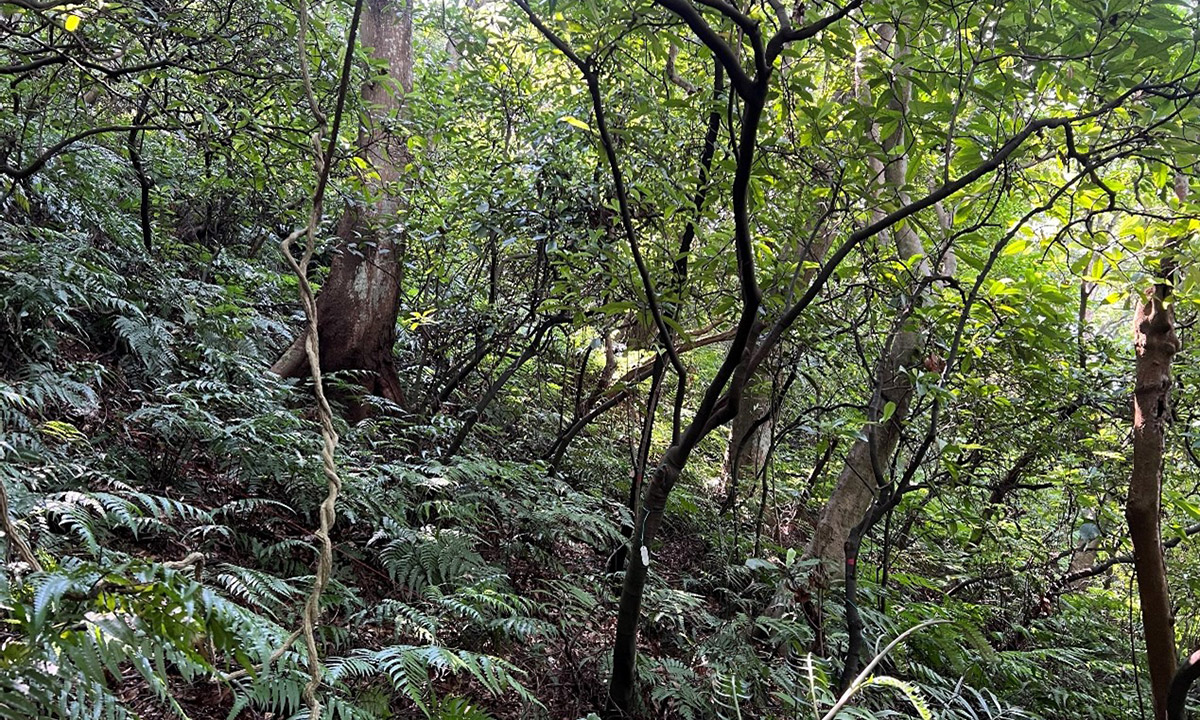 Fuyang Natural Eco Park fern ground cover and incense nanmu giant trees (Provided by Wei-Yu Wang.)
Current status of Fuyang forest's flora
Fuyang Natural Eco Park fern ground cover and incense nanmu giant trees (Provided by Wei-Yu Wang.)
Current status of Fuyang forest's flora
Since 2019, Fuyang Eco Park has commissioned plant experts to conduct detailed plant resource surveys and set up permanent monitoring plots for both woody and herbaceous plants. These efforts aim to understand the current changes in plant composition and forest regeneration. In total, 111 families (according to the APG IV system), including 7 subspecies, 41 varieties, and 366 species and infraspecific taxon, were recorded. The most numerous families, in descending order, were Asteraceae (20 species), Moraceae (15 species), Rubiaceae (14 species), Poaceae (12 species), Euphorbiaceae, Araceae, and Pteridaceae, each with 11 species. Among these, 253 are native species, accounting for 69.13% of all recorded plants, while 113 were exotic species (cultivated or naturalized). Exotic species, mainly ornamental flowers, are represented in several families such as Araceae, Asparagaceae, Acanthaceae, Asteraceae, and Poaceae. Some species, including the walking iris (
Neomarica gracilis), aglaonema (
Aglaonema modestum), dumbcane (
Dieffenbachia maculata), golden pothos (
Epipremnum aureum), arrow-head vine (
Syngonium podophyllum), peace lily (
Spathiphyllum kochii), common dracena (
Cordyline fruticosa), lucky bamboo (
Dracaena sanderiana), frangrant dracaena (
Dracaena fragrans), snake plant (
Sansevieria trifasciata) and Brazilian petunia (
Ruellia elegans), cover a substantial area and exhibit clear signs of naturalization. According to the database of Taiwan's invasive exotic species maintained by the Taiwan Forestry Research Institute of the Council of Agriculture, there are 11 invasive plant species in the park, including arrow-head vine, flossflower (
Ageratum houstonianum), Canadian horseweed (
Conyza canadensis), tall fleabane (Conyza sumatrensis), nodding burnweed (
Crassocephalum crepidioides), bittervine (
Mikania micrantha), Mexican sunflower (
Tithonia diversifolia), busy Lizzie (
Impatiens walleriana), vine spinach (Basella alba), miracle leaf (
Bryophyllum pinnatum), and weed passion flower (
Passiflora foetida var.
hispida). These species can be observed sporadically within the park.
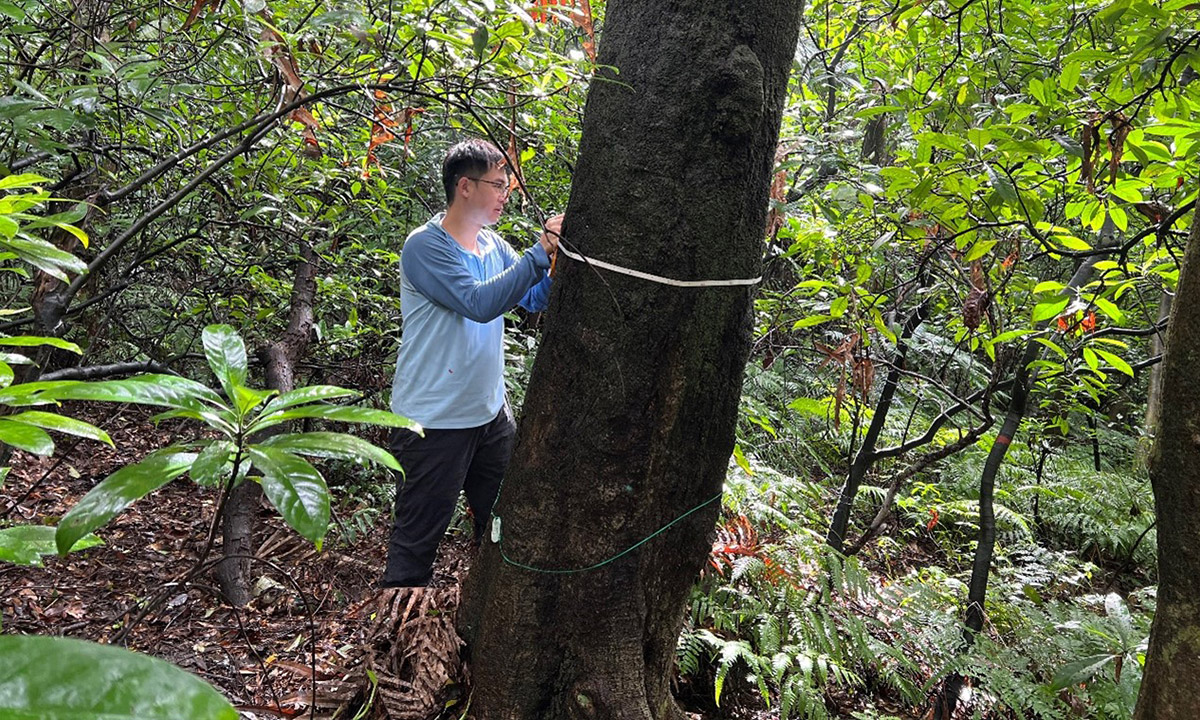 Monitoring survey of woody plants in Fuyang Eco Park (Provided by Wei-Yu Wang.)
Damage to the boundaries of Fuyang forest (invasion of alien plants)
Monitoring survey of woody plants in Fuyang Eco Park (Provided by Wei-Yu Wang.)
Damage to the boundaries of Fuyang forest (invasion of alien plants)
An intact forest structure acts as a robust defense, forming a natural boundary at the forest edge that can effectively prevent many light-loving exotic plants from invading. These include bittervine, flossflower, Canadian horseweed, tall fleabane, nodding burnweed, vine spinach, and miracle leaf. These plants mostly grow at the forest edge and along roadsides. Only a few individuals can be found along the trails. However, due to high levels of human activity, such as the unauthorized removal of vegetation and the planting of exotic species, the forest's environment has been altered, unintentionally providing invasive exotic plants with a pathway into the forest. Fuyang Eco Park's natural ground cover faces increasing competition from these exotic species.
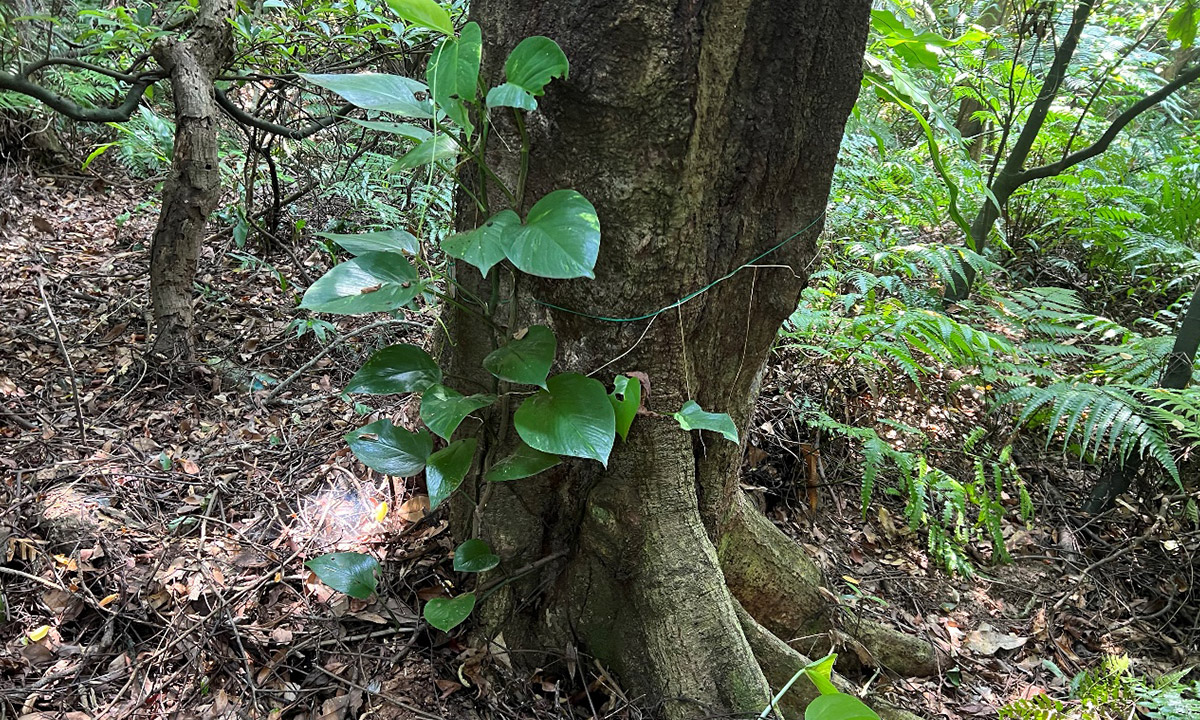 Exotic climbing plants golden pothos has started to climb trees (Provided by Wei-Yu Wang.)
Proliferation of understory cultivated plants
Exotic climbing plants golden pothos has started to climb trees (Provided by Wei-Yu Wang.)
Proliferation of understory cultivated plants
While the invasion of exotic plants is often a topic of concern for government agencies and the public, the impact of cultivated plants is frequently overlooked. The practice of abandoning plants at random within the park or deliberately planting horticultural flowers along the trails and in the understory directly introduces many exotic species into the forest. The survey revealed that in areas that were originally dominated by ferns, walking iris, aglaonema, dumbcane, golden pothos, arrow-head vine, peace lily, common dracena, lucky bamboo, frangrant dracaena, snake plant, and Brazilian petunia have replaced most native plants. However, only the arrow-head vine is officially recognized as an invasive species. In other words, many exotic plants that impact the composition of Fuyang Eco Park's vegetation have been ignored or gone unnoticed. These species are shade-tolerant and have excellent vegetative propagation abilities, making them highly adapted to the park's forest environment. The forest's natural defense network is clearly ineffective against these species. In the permanent monitoring plots for herbaceous plants, the presence of native plants waxes and wanes with the seasons and changing environmental conditions. However, if invasive exotic plants grow in the plots, their growth clearly increases seasonally, demonstrating their strong survival abilities. This also suggests that the park's native plants are becoming less competitive, potentially facing replacement, which could ultimately lead to a decrease in biodiversity.
The arrow-head vine and golden pothos are common exotic plants in the low-elevation mountain areas. In their juvenile stage, these plants first cover the forest's ground cover layer and gradually climb up tree trunks. They produce roots at stem nodes, facilitating attachment, and silently extend their reach into the canopy. Their stems and leaves progressively enlarge. However, native woody plants in low-elevation mountain forests may not be able to support such large climbing plants. Unsuitable growth conditions can lead to native plants weakening or breaking, resulting in gaps in the forest's defense network, opening the door for invasive exotic plants. This causes a change in the forest's structure.
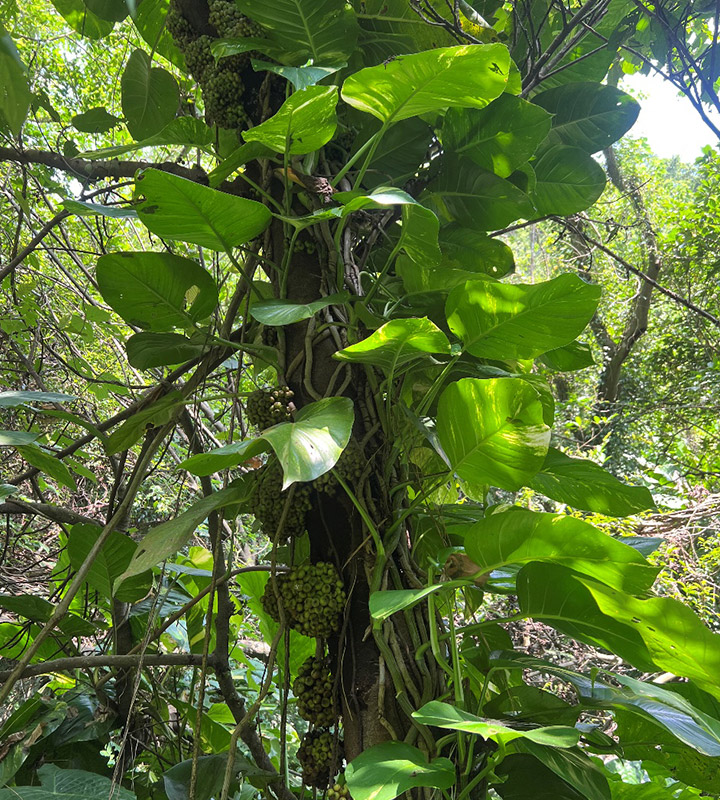 Common yellow stem-fig that has been attached to Golden Pothos (Provided by Wei-Yu Wang.)
Common yellow stem-fig that has been attached to Golden Pothos (Provided by Wei-Yu Wang.)
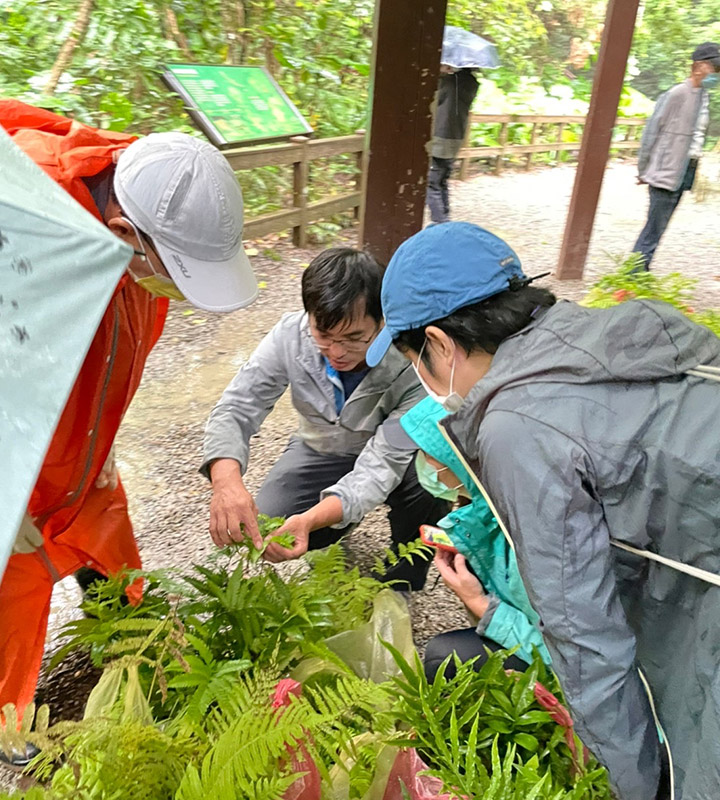 Explaining how to remove exotic plants and replant native ferns in Fuyang Eco Park (Provided by Wei-Yu Wang.)
Repairing the wounds of Fuyang forest
Explaining how to remove exotic plants and replant native ferns in Fuyang Eco Park (Provided by Wei-Yu Wang.)
Repairing the wounds of Fuyang forest
With the support of the Wistron Foundation, the Society of Wilderness has been managing and monitoring Fuyang Eco Park for a long time. The compilation of long-term biological resource data and plant monitoring results has enabled us to grasp the existing plant composition and potential future alterations in forest succession, as well as the effects of exotic plants on native vegetation. It is essential to educate the public about the value and characteristics of Fuyang Eco Park's forest environment and raise awareness of the impact and destructiveness of exotic plants on forest vegetation, which is the most important way to reduce human interference. Additionally, organizing activities to remove invasive plants with the participation of the public and volunteers allows them to personally experience the forest ecology of Fuyang Eco Park. These activities are also particularly helpful to spread the message of "not planting plants at will." While planting these ornamental plants only requires a momentary thought, removing a small cluster of well-grown walking irises may take an entire morning and some will invariably be left out. During the removal process, it can be observed that there are almost no other companion plants growing in the covered area, indicating the replacement capability of invasive exotic plants on the native ground cover. After removal, the bare ground becomes suitable for many exotic plants. If there are no follow-up actions, this only creates more opportunities for their survival. Therefore, after removal, native plant species suitable for the local environment should be selected for replanting based on the results of plant surveys. Engaging the public in removing exotic species and planting native species can effectively convey the desired concepts and repair the damage of the forest in Fuyang Eco Park.
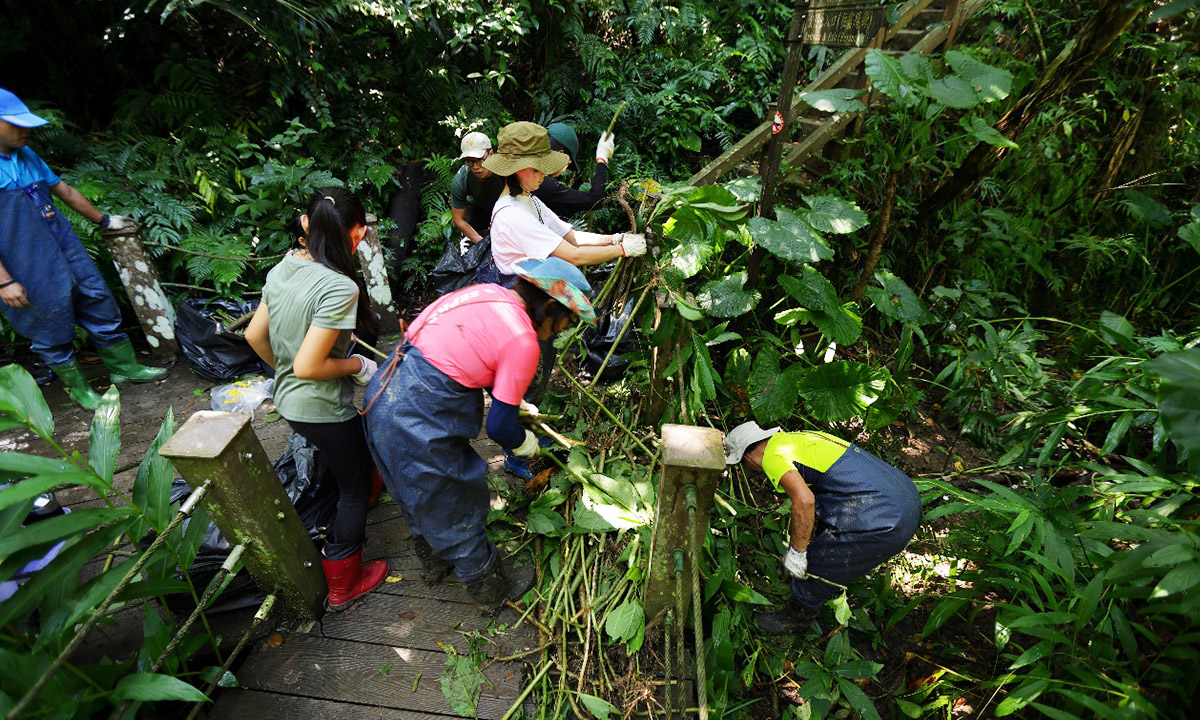 Wistron volunteers remove exotic plants in Fuyang Eco Park (Courtesy of National Geographic)
Wistron volunteers remove exotic plants in Fuyang Eco Park (Courtesy of National Geographic)
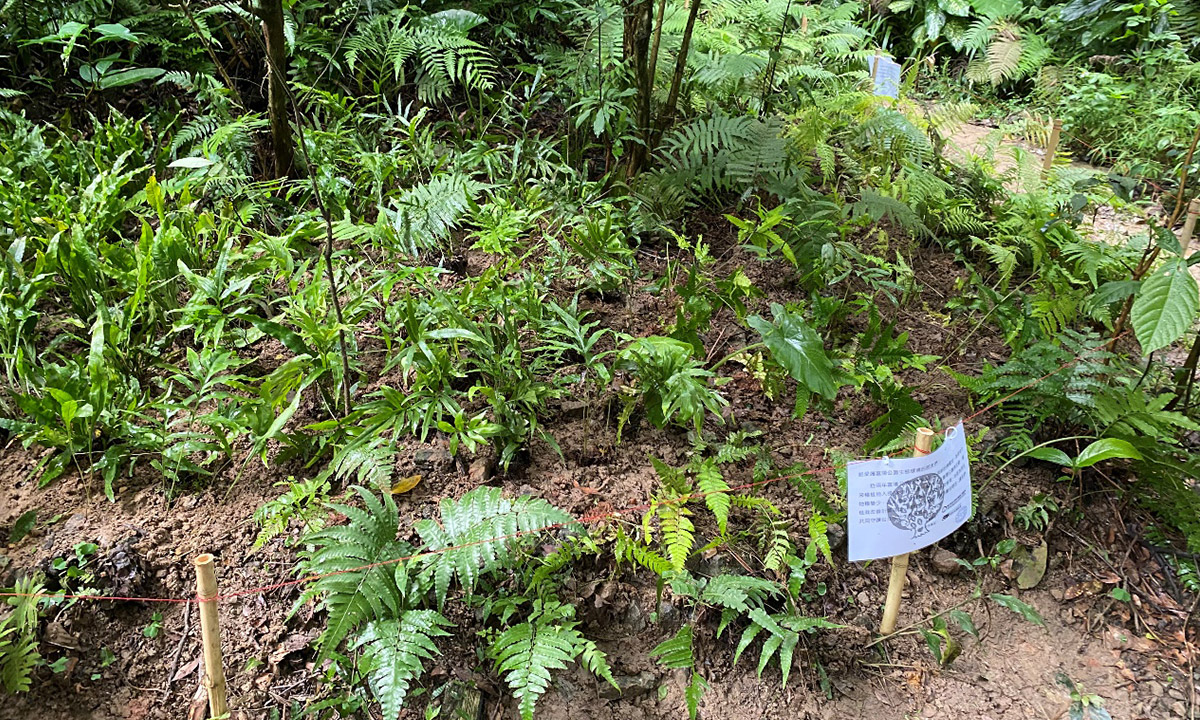 Results of replanting native ferns after removing invasive Plants (Provided by Wei-Yu Wang)
Results of replanting native ferns after removing invasive Plants (Provided by Wei-Yu Wang)
 Fuyang Natural Eco Park fern ground cover and incense nanmu giant trees (Provided by Wei-Yu Wang.)
Current status of Fuyang forest's flora
Since 2019, Fuyang Eco Park has commissioned plant experts to conduct detailed plant resource surveys and set up permanent monitoring plots for both woody and herbaceous plants. These efforts aim to understand the current changes in plant composition and forest regeneration. In total, 111 families (according to the APG IV system), including 7 subspecies, 41 varieties, and 366 species and infraspecific taxon, were recorded. The most numerous families, in descending order, were Asteraceae (20 species), Moraceae (15 species), Rubiaceae (14 species), Poaceae (12 species), Euphorbiaceae, Araceae, and Pteridaceae, each with 11 species. Among these, 253 are native species, accounting for 69.13% of all recorded plants, while 113 were exotic species (cultivated or naturalized). Exotic species, mainly ornamental flowers, are represented in several families such as Araceae, Asparagaceae, Acanthaceae, Asteraceae, and Poaceae. Some species, including the walking iris (Neomarica gracilis), aglaonema (Aglaonema modestum), dumbcane (Dieffenbachia maculata), golden pothos (Epipremnum aureum), arrow-head vine (Syngonium podophyllum), peace lily (Spathiphyllum kochii), common dracena (Cordyline fruticosa), lucky bamboo (Dracaena sanderiana), frangrant dracaena (Dracaena fragrans), snake plant (Sansevieria trifasciata) and Brazilian petunia (Ruellia elegans), cover a substantial area and exhibit clear signs of naturalization. According to the database of Taiwan's invasive exotic species maintained by the Taiwan Forestry Research Institute of the Council of Agriculture, there are 11 invasive plant species in the park, including arrow-head vine, flossflower (Ageratum houstonianum), Canadian horseweed (Conyza canadensis), tall fleabane (Conyza sumatrensis), nodding burnweed (Crassocephalum crepidioides), bittervine (Mikania micrantha), Mexican sunflower (Tithonia diversifolia), busy Lizzie (Impatiens walleriana), vine spinach (Basella alba), miracle leaf (Bryophyllum pinnatum), and weed passion flower (Passiflora foetida var. hispida). These species can be observed sporadically within the park.
Fuyang Natural Eco Park fern ground cover and incense nanmu giant trees (Provided by Wei-Yu Wang.)
Current status of Fuyang forest's flora
Since 2019, Fuyang Eco Park has commissioned plant experts to conduct detailed plant resource surveys and set up permanent monitoring plots for both woody and herbaceous plants. These efforts aim to understand the current changes in plant composition and forest regeneration. In total, 111 families (according to the APG IV system), including 7 subspecies, 41 varieties, and 366 species and infraspecific taxon, were recorded. The most numerous families, in descending order, were Asteraceae (20 species), Moraceae (15 species), Rubiaceae (14 species), Poaceae (12 species), Euphorbiaceae, Araceae, and Pteridaceae, each with 11 species. Among these, 253 are native species, accounting for 69.13% of all recorded plants, while 113 were exotic species (cultivated or naturalized). Exotic species, mainly ornamental flowers, are represented in several families such as Araceae, Asparagaceae, Acanthaceae, Asteraceae, and Poaceae. Some species, including the walking iris (Neomarica gracilis), aglaonema (Aglaonema modestum), dumbcane (Dieffenbachia maculata), golden pothos (Epipremnum aureum), arrow-head vine (Syngonium podophyllum), peace lily (Spathiphyllum kochii), common dracena (Cordyline fruticosa), lucky bamboo (Dracaena sanderiana), frangrant dracaena (Dracaena fragrans), snake plant (Sansevieria trifasciata) and Brazilian petunia (Ruellia elegans), cover a substantial area and exhibit clear signs of naturalization. According to the database of Taiwan's invasive exotic species maintained by the Taiwan Forestry Research Institute of the Council of Agriculture, there are 11 invasive plant species in the park, including arrow-head vine, flossflower (Ageratum houstonianum), Canadian horseweed (Conyza canadensis), tall fleabane (Conyza sumatrensis), nodding burnweed (Crassocephalum crepidioides), bittervine (Mikania micrantha), Mexican sunflower (Tithonia diversifolia), busy Lizzie (Impatiens walleriana), vine spinach (Basella alba), miracle leaf (Bryophyllum pinnatum), and weed passion flower (Passiflora foetida var. hispida). These species can be observed sporadically within the park.
 Monitoring survey of woody plants in Fuyang Eco Park (Provided by Wei-Yu Wang.)
Damage to the boundaries of Fuyang forest (invasion of alien plants)
An intact forest structure acts as a robust defense, forming a natural boundary at the forest edge that can effectively prevent many light-loving exotic plants from invading. These include bittervine, flossflower, Canadian horseweed, tall fleabane, nodding burnweed, vine spinach, and miracle leaf. These plants mostly grow at the forest edge and along roadsides. Only a few individuals can be found along the trails. However, due to high levels of human activity, such as the unauthorized removal of vegetation and the planting of exotic species, the forest's environment has been altered, unintentionally providing invasive exotic plants with a pathway into the forest. Fuyang Eco Park's natural ground cover faces increasing competition from these exotic species.
Monitoring survey of woody plants in Fuyang Eco Park (Provided by Wei-Yu Wang.)
Damage to the boundaries of Fuyang forest (invasion of alien plants)
An intact forest structure acts as a robust defense, forming a natural boundary at the forest edge that can effectively prevent many light-loving exotic plants from invading. These include bittervine, flossflower, Canadian horseweed, tall fleabane, nodding burnweed, vine spinach, and miracle leaf. These plants mostly grow at the forest edge and along roadsides. Only a few individuals can be found along the trails. However, due to high levels of human activity, such as the unauthorized removal of vegetation and the planting of exotic species, the forest's environment has been altered, unintentionally providing invasive exotic plants with a pathway into the forest. Fuyang Eco Park's natural ground cover faces increasing competition from these exotic species.
 Exotic climbing plants golden pothos has started to climb trees (Provided by Wei-Yu Wang.)
Proliferation of understory cultivated plants
While the invasion of exotic plants is often a topic of concern for government agencies and the public, the impact of cultivated plants is frequently overlooked. The practice of abandoning plants at random within the park or deliberately planting horticultural flowers along the trails and in the understory directly introduces many exotic species into the forest. The survey revealed that in areas that were originally dominated by ferns, walking iris, aglaonema, dumbcane, golden pothos, arrow-head vine, peace lily, common dracena, lucky bamboo, frangrant dracaena, snake plant, and Brazilian petunia have replaced most native plants. However, only the arrow-head vine is officially recognized as an invasive species. In other words, many exotic plants that impact the composition of Fuyang Eco Park's vegetation have been ignored or gone unnoticed. These species are shade-tolerant and have excellent vegetative propagation abilities, making them highly adapted to the park's forest environment. The forest's natural defense network is clearly ineffective against these species. In the permanent monitoring plots for herbaceous plants, the presence of native plants waxes and wanes with the seasons and changing environmental conditions. However, if invasive exotic plants grow in the plots, their growth clearly increases seasonally, demonstrating their strong survival abilities. This also suggests that the park's native plants are becoming less competitive, potentially facing replacement, which could ultimately lead to a decrease in biodiversity.
The arrow-head vine and golden pothos are common exotic plants in the low-elevation mountain areas. In their juvenile stage, these plants first cover the forest's ground cover layer and gradually climb up tree trunks. They produce roots at stem nodes, facilitating attachment, and silently extend their reach into the canopy. Their stems and leaves progressively enlarge. However, native woody plants in low-elevation mountain forests may not be able to support such large climbing plants. Unsuitable growth conditions can lead to native plants weakening or breaking, resulting in gaps in the forest's defense network, opening the door for invasive exotic plants. This causes a change in the forest's structure.
Exotic climbing plants golden pothos has started to climb trees (Provided by Wei-Yu Wang.)
Proliferation of understory cultivated plants
While the invasion of exotic plants is often a topic of concern for government agencies and the public, the impact of cultivated plants is frequently overlooked. The practice of abandoning plants at random within the park or deliberately planting horticultural flowers along the trails and in the understory directly introduces many exotic species into the forest. The survey revealed that in areas that were originally dominated by ferns, walking iris, aglaonema, dumbcane, golden pothos, arrow-head vine, peace lily, common dracena, lucky bamboo, frangrant dracaena, snake plant, and Brazilian petunia have replaced most native plants. However, only the arrow-head vine is officially recognized as an invasive species. In other words, many exotic plants that impact the composition of Fuyang Eco Park's vegetation have been ignored or gone unnoticed. These species are shade-tolerant and have excellent vegetative propagation abilities, making them highly adapted to the park's forest environment. The forest's natural defense network is clearly ineffective against these species. In the permanent monitoring plots for herbaceous plants, the presence of native plants waxes and wanes with the seasons and changing environmental conditions. However, if invasive exotic plants grow in the plots, their growth clearly increases seasonally, demonstrating their strong survival abilities. This also suggests that the park's native plants are becoming less competitive, potentially facing replacement, which could ultimately lead to a decrease in biodiversity.
The arrow-head vine and golden pothos are common exotic plants in the low-elevation mountain areas. In their juvenile stage, these plants first cover the forest's ground cover layer and gradually climb up tree trunks. They produce roots at stem nodes, facilitating attachment, and silently extend their reach into the canopy. Their stems and leaves progressively enlarge. However, native woody plants in low-elevation mountain forests may not be able to support such large climbing plants. Unsuitable growth conditions can lead to native plants weakening or breaking, resulting in gaps in the forest's defense network, opening the door for invasive exotic plants. This causes a change in the forest's structure.
 Common yellow stem-fig that has been attached to Golden Pothos (Provided by Wei-Yu Wang.)
Common yellow stem-fig that has been attached to Golden Pothos (Provided by Wei-Yu Wang.)
 Explaining how to remove exotic plants and replant native ferns in Fuyang Eco Park (Provided by Wei-Yu Wang.)
Repairing the wounds of Fuyang forest
With the support of the Wistron Foundation, the Society of Wilderness has been managing and monitoring Fuyang Eco Park for a long time. The compilation of long-term biological resource data and plant monitoring results has enabled us to grasp the existing plant composition and potential future alterations in forest succession, as well as the effects of exotic plants on native vegetation. It is essential to educate the public about the value and characteristics of Fuyang Eco Park's forest environment and raise awareness of the impact and destructiveness of exotic plants on forest vegetation, which is the most important way to reduce human interference. Additionally, organizing activities to remove invasive plants with the participation of the public and volunteers allows them to personally experience the forest ecology of Fuyang Eco Park. These activities are also particularly helpful to spread the message of "not planting plants at will." While planting these ornamental plants only requires a momentary thought, removing a small cluster of well-grown walking irises may take an entire morning and some will invariably be left out. During the removal process, it can be observed that there are almost no other companion plants growing in the covered area, indicating the replacement capability of invasive exotic plants on the native ground cover. After removal, the bare ground becomes suitable for many exotic plants. If there are no follow-up actions, this only creates more opportunities for their survival. Therefore, after removal, native plant species suitable for the local environment should be selected for replanting based on the results of plant surveys. Engaging the public in removing exotic species and planting native species can effectively convey the desired concepts and repair the damage of the forest in Fuyang Eco Park.
Explaining how to remove exotic plants and replant native ferns in Fuyang Eco Park (Provided by Wei-Yu Wang.)
Repairing the wounds of Fuyang forest
With the support of the Wistron Foundation, the Society of Wilderness has been managing and monitoring Fuyang Eco Park for a long time. The compilation of long-term biological resource data and plant monitoring results has enabled us to grasp the existing plant composition and potential future alterations in forest succession, as well as the effects of exotic plants on native vegetation. It is essential to educate the public about the value and characteristics of Fuyang Eco Park's forest environment and raise awareness of the impact and destructiveness of exotic plants on forest vegetation, which is the most important way to reduce human interference. Additionally, organizing activities to remove invasive plants with the participation of the public and volunteers allows them to personally experience the forest ecology of Fuyang Eco Park. These activities are also particularly helpful to spread the message of "not planting plants at will." While planting these ornamental plants only requires a momentary thought, removing a small cluster of well-grown walking irises may take an entire morning and some will invariably be left out. During the removal process, it can be observed that there are almost no other companion plants growing in the covered area, indicating the replacement capability of invasive exotic plants on the native ground cover. After removal, the bare ground becomes suitable for many exotic plants. If there are no follow-up actions, this only creates more opportunities for their survival. Therefore, after removal, native plant species suitable for the local environment should be selected for replanting based on the results of plant surveys. Engaging the public in removing exotic species and planting native species can effectively convey the desired concepts and repair the damage of the forest in Fuyang Eco Park.
 Wistron volunteers remove exotic plants in Fuyang Eco Park (Courtesy of National Geographic)
Wistron volunteers remove exotic plants in Fuyang Eco Park (Courtesy of National Geographic)
 Results of replanting native ferns after removing invasive Plants (Provided by Wei-Yu Wang)
Results of replanting native ferns after removing invasive Plants (Provided by Wei-Yu Wang)




 中
中